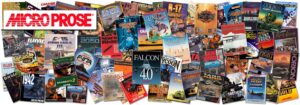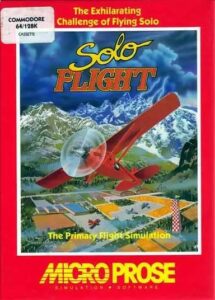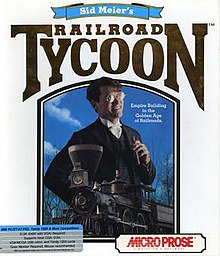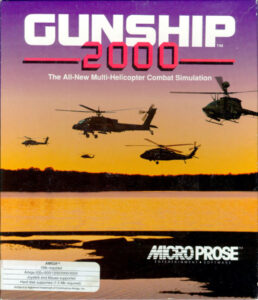MicroProse
MicroProse, (MPS), was an American video game publisher and developer founded by Bill Stealey (Wild Bill), and Sid Meier in 1982. MPS developed and published numerous games, many of which are regarded as groundbreaking, classics and cult titles, including F-15 Strike Eagle, Gunship, M1 Tank Platoon, F-19 Stealth Fighter, Railroad Tycoon, and Civilization. Many of their internally developed titles were vehicle simulation and strategy games.
Stealey and Meier both worked at General Instrument in Hunt Valley, Md. Stealey was the Director of Strategic Planning, primarily a finance job. Meier was a systems analyst who had broad interests in music, history, and games. They met because Meier had a user’s group called SMUGGERs, or Sid Meier’s User Group for Atari computers and Stealey had purchased an Atari 800 to do financial work using Visicalc.
After a well document game challenge event in the Bally’s hotel in Las Vegas during a sales event, where Meier beat Stealey at an arcade game called Red Baron, Meier bragged that he could write a better game in a week. Not to be out bragged, Stealey, at the time a Jet Fighter Pilot, said if Meier could, he could sell it. Two months later Stealey got Hellcat Ace and started selling.
Stealey telemarketed Meier’s games for over 18 months to generate the first revenues for MicroProse. Stealey left GI in 1983 to go full time at MicroProse and Meier joined full time about a year later.
The first real breakthrough game was Solo Flight followed by F-15 Strike Eagle. Stealey like to focus on the military simulations as he was an Air Force Officer flying for the PA ANG in A-37 Dragonfly aircraft. Meier was a history buff and a board game enthusiast and enjoyed strategy games more. Meier’s Railroad Tycoon and Civilization were both inspired by board games from Avalon Hill that MicroProse got permission to sell.
From a start in Stealey’s basement in 1982 with just one of Sid Meier’s games, Hellcat Ace, the company grew over 11 years to over $45 million in annual sales and over 500 worldwide employees, with a Public Stock Offering of a valuation over $400 million in 1991.
Games
In 1992, with a new Board of Directors and a newly hired MicroProse Chief Operating Officer for the USA Division, Stealey left the company for 6 months for a sabbatical to travel, make speeches on Entrepreneurism at business schools, and work on his golf game.
Six great new AAA games were due on Oct 1, 1992. When Stealey returned in September 1992, it was discovered none of the games were ready. MPS only put out one AAA title, F-15 Strike Eagle III, on December 15th, 1992. Cash became the issue with only one new AAA game for 1992.
Stealey had given Gilman Louie’s Spectrum Holybyte company a $500,000 advance in December of 1991 when Spectrum’s primary investor, Brit Robert Maxwell was found drown of the coast of Spain. Stealey called Gilman in May of 1993 for return help. Stealey was trying to overcome a cash crunch from the lack of new games in 1992 and called Gilman to bring his Venture Capital Group, Kleiner, Perkins, Caufield & Byers to the rescue of MPS. Kleiner bought enough stock of MicroProse to take control of the MPS Board and install Mr. Louie as the new CEO, in June 1993.
Stealey left the Board of Directors in the fall of 1993 to retire.
Subsequent cuts and corporate policies led to Sid Meier, Jeff Briggs and Brian Reynolds leaving and forming Firaxis Games in 1996, as MicroProse closed its ex-Simtex development studio in Austin, Texas. In 1998, following an unsuccessful buyout attempt by GT Interactive Software, the struggling MicroProse (Spectrum HoloByte) became a wholly-owned subsidiary of Hasbro Interactive and its development studios in Alameda, California and Chapel Hill, North Carolina were closed the following year. In 2001, MicroProse ceased to exist as an entity and Hasbro Interactive sold the MicroProse intellectual properties to Infogrames Entertainment, SA. MicroProse UK’s former main office in Chipping Sodbury was closed in 2002, followed by the company’s former headquarters in Hunt Valley, Maryland in 2003.
The brand was revived in 2007 when Interactive Game Group acquired it from Atari Interactive, formerly Infogrames. The MicroProse brand was licensed to the Legacy Engineering Group for consumer electronics. Cybergun owned the MicroProse brand from 2010 to 2018.
David Lagettie, an Australian Defense Industry Entrepreneur, CEO of three defense companies, began acquiring MicroProse licenses from 2004. He got the MicroProse logo and brand finally in 2018 and relaunched a website MicroProse.com.
MicroProse Ltd, of New South Wales, Australia has announced 4 new military simulation type games for release in late 2020. It is known that MicroProse Ltd. has many other simulation games under development.
Stealey is now assisting MicroProse in Marketing and has presented MicroProse at two recent Pocket Gamer online conferences.
History
Independent company (1982–1993) 1980s
In summer 1982, Stealey and Meier were the Finance and Technical representatives at a General Instrument sales conference in Los Vegas. Both were bored listening to sales presentations and Meier knew Stealey was as interested in games and simulation as he was. He invited Stealey to skip out on the last sales presentations and go have some fun in the arcade video game room.
After Meier surprised Stealey, (an actual Air Force Command Pilot and Lt. Colonel, USAF, Retired), by defeating him when playing Red Baron, a flying game from Atari. Sid explained that he had analyzed the game’s programming to predict future actions and claimed that he could design a better game in one week. Stealey promised to sell the game if Meier could develop it.
Although Meier needed two months to produce Hellcat Ace, Stealey sold 100 copies in his first sales appointment in October 1982, and the game became the first product of their new company.[1] They thought to name the company, Smugger’s Software, but chose MicroProse instead as Stealey did not think the Smuggers was good to sell from. (In 1987 the company agreed to change its name to avoid confusion with MicroPro International, but MicroPro decided to rename itself after its WordStar word processor).[2] MicroProse became profitable in its second month and had $10 million in sales by 1986.[3] Stealey was the businessman who could sell and acquire staff around Sid and his development work. Stealey ran the business while Sid worked his development magic and helped all the new staff convert much of Sid’s Atari 800 games to the C-64 and other formats.
MicroProse advertised its first batch of games in 1982, under the headline “Experience the MicroProse Challenge!!!” All three were written by Sid Meier for the Atari 8-bit family of home computers: platformer Floyd of the Jungle,[4] 2D shooter Chopper Rescue,[5] and first-person airplane combat game Hellcat Ace.[6] Hellcat Ace began a series of increasingly sophisticated 8-bit flight simulation games, including Spitfire Ace (1982) and Solo Flight (1983), that defined the company.
In 1983, MicroProse ported Floyd of the Jungle to the Commodore 64, their first product for that machine. By 1984, the company had begun supporting the Apple II and PC Junior and IBM compatibles. MicroProse released the air traffic control game Kennedy Approach, written by Andy Hollis, in 1985.[7] Conflict in Vietnam (1986) was the final MicroProse title for the Atari 8-bit line.
By 1987, Computer Gaming World considered MicroProse one of the top five computer game companies, alongside likes of Activision and Electronic Arts. The PC market was, along with the Commodore 64, the company’s top priority. By 1989, support for 8-bit machines was dropped. MicroProse supported the Amiga and developed for that machine its entire nine years on the market (Amiga development was outsourced to MicroProse UK in 1991).
MicroProse also started a branch in the United Kingdom in Tetbury England, to cross-publish titles in Europe,[3] and to import some European titles to be published in the United States. The European Division of MicroProse grew to over $10 million in annual sales in just two years.
Notable products from this period include simulation games F-15 Strike Eagle, F-19 Stealth Fighter, Gunship, Project Stealth Fighter, Red Storm Rising and Silent Service, and action-strategy games such as Sid Meier’s Pirates! and Sword of the Samurai. Several games from different developers were also distributed by MicroProse under the labels “Firebird” and “Rainbird” (acquired after buying Telecomsoft in 1989), including Carrier Command, Midwinter and Savage.
MicroProse also opened offices in Tokyo Japan, Paris France, and West Germany that helped sell millions of MicroProse games.
1990s
In the early 1990s, MicroProse released the hit strategy games Railroad Tycoon and Sid Meier’s Civilization, inspired by the Avalon Hill Board games of the same names, designed by Meier and developed by its internal division, MPS Labs, on multiple platforms. Critically acclaimed, both of them quickly became two of the best-selling strategy games of all time and spawned multiple sequels. Some of MicroProse’s simulation games from the 1980s received remakes in the early 1990s, such as Night Hawk: F-117A Stealth Fighter 2.0, Silent Service II and Gunship 2000, and made some first cautious attempts to expand into the console market with F-117A Stealth Fighter and Super Strike Eagle (MicroProse also ported several of their titles to the 16- and 32-bit consoles during the mid-1990s). Brand new simulation and strategy titles included 1942: The Pacific Air War, Dogfight, Fields of Glory, Formula One Grand Prix, Harrier Jump Jet, Knights of the Sky, Starlord, Subwar 2050 and Task Force 1942.
At the same time, MicroProse attempted to diversify beyond its niche roots as a sim and strategy game company. Encouraged by the success of Pirates!, MicroProse designed further action-strategy titles such as Covert Action (also designed by Sid Meier) and Hyperspeed, and experimented with the role-playing genre by developing BloodNet and Darklands (in addition to publishing The Legacy: Realm of Terror). The company invested (and subsequently effectively lost) a large sum of money to create its arcade game division as well as their own graphic adventure game engine. However, the arcade division was canceled after making only two games: F-15 Strike Eagle: The Arcade Game and Battle of the Solar System (both of which featured high-end 3D graphics but failed to become popular as they were too different from existing machines), while the adventure game engine was used for just three games: Rex Nebular and the Cosmic Gender Bender, Return of the Phantom and Dragonsphere, before it was sold off to Sanctuary Woods
In August 1991, MicroProse filed for an Initial Public Offering. The company raised over $25 million to help repay debts from its unsuccessful arcade games.[8] During the same period, MicroProse created two labels: MicroStyle (UK), and MicroPlay Software (US), using them for publishing a variety of externally developed games, such as Challenge of the Five Realms, Global Conquest, Elite Plus, Flames of Freedom, Rick Dangerous, Stunt Car Racer, Xenophobe and XF5700 Mantis.[9][10] In 1992 MicroProse acquired Paragon Software.[11] It also acquired Leeds-based flight simulation developer Vektor Grafix,[12] which had already developed titles for them (such as B-17 Flying Fortress), turning it into a satellite development studio named MicroProse Leeds.
Under Spectrum HoloByte (1993–1998)
In June 1993, following Black Wednesday in the UK, MicroProse Software Inc. merged with Spectrum HoloByte, another game company that specialized in simulation games, to form MicroProse Inc.[13] Bill Stealey, who was good friends with Spectrum HoloByte president Gilman Louie, convinced Louie to help MicroProse. MicroProse UK was forced to close its two satellite studios of MicroProse in northern England and dispose of over 40 staff at its Chipping Sodbury head office (MicroProse Chipping Sodbury). A core group of artists, designers, and programmers left MicroProse UK to join Psygnosis, which opened an office in Stroud specifically to attract ex-MicroProse employees. Stealey departed MicroProse. He later commented, “Spectrum Holobyte had a lot of cash and very few products. MicroProse had a lot of products and no cash. It was a great marriage, but the new company only needed one chairman, so I resigned.”[14] Stealey went on to found an independent game company Interactive Magic (also specializing in vehicle simulators and strategy games), while Andy Hollis departed for Origin Systems, and Sandy Petersen joined id Software.
Despite cuts, Spectrum Holobyte managed to line up several big name licenses, including Top Gun (Top Gun: Fire At Will), Magic: The Gathering (Magic: The Gathering), Star Trek: The Next Generation (A Final Unity, Birth of the Federation, Klingon Honor Guard) and MechWarrior (MechCommander, MechWarrior 3). Strategy game UFO: Enemy Unknown (X-COM: UFO Defense) proved to be an unanticipated hit in 1994, spawning multiple sequels. In 1996, Spectrum HoloByte/MicroProse bought out Simtex, earlier a developer of MicroProse-published bestsellers Master of Orion and Master of Magic. Simtex was re-branded as MicroProse Texas (Master of Orion II: Battle at Antares), based in Austin, Texas. Other MicroProse developed and/or published games during that period included 7th Legion, Addiction Pinball, AEGIS: Guardian of the Fleet, Civilization II, Dark Earth, F-15 Strike Eagle III, Fleet Defender, Grand Prix 2, Pizza Tycoon, Sid Meier’s Colonization, Tinhead, Transport Tycoon, X-COM: Apocalypse, X-COM: Interceptor and X-COM: Terror from the Deep. Insufficient financial resources largely prevented MicroProse from developing games for other game platforms, therefore MicroProse concentrated on the PC game market.[15]
MicroProse Software continued as separate subsidiary company under Spectrum HoloByte until 1996. That year, Spectrum HoloByte started cutting a majority of the MicroProse staff to reduce costs. Soon after, it consolidated all of its titles under the MicroProse brand (essentially renaming itself MicroProse). MicroProse’s remaining co-founder Sid Meier, along with Jeff Briggs and Brian Reynolds, departed the company after the staff cut, forming a new company named Firaxis Games.[16]
On October 5, 1997, GT Interactive Software announced that it had signed a definitive agreement to acquire MicroProse for $250 million in stock, the deal had even been unanimously approved by the Board of Directors of both companies. After the announcement MicroProse’s stock price reached $7 a share. GT Interactive expected the deal to be completed by the end of that year.[17][18] But the acquisition was cancelled on December 5, as according to both CEOs “the time is simply not right” for the deal. MicroProse’s stock plummeted to just $2.31 after the announcement of the deal’s cancellation.[19] According to Computer Gaming World, the merger was annulled due to a “fundamental” disagreement over how the joint company would be writing off its research and development costs, as MicroProse insisted to keep their method of paying off the developer immediately.[20]
In November 1997, MicroProse was sued by both Avalon Hill (who had the U.S. publishing rights to the name Civilization)[21] and Activision for copyright infringement. MicroProse responded by buying Hartland Trefoil, which was the original designer and manufacturer of the Civilization board game, and then sued Avalon Hill and Activision for trademark infringement and unfair business practices as a result of Activision’s decision to develop and publish Civilization video games.[22] Because Hasbro was negotiating the acquisition of both Avalon Hill and MicroProse, the lawsuits were settled in July 1998. Under the terms of the settlement MicroProse became the sole owner of the rights of the name Civilization and Activision acquired a license to publish a Civilization video game which was later titled Civilization: Call to Power.[21][23]
Under Hasbro Interactive (1998–2001)
In preparation for its sale, MicroProse closed down its studio in Austin in June 1998; as a result of the closure, 35 employees lost their jobs. On August 14, 1998, Hasbro issued a $70 million cash tender offer to purchase all MicroProse’s shares for $6 each. This deal was completed on September 14, when Hasbro bought 91% of MicroProse’s shares and announced that MicroProse had become a wholly owned subsidiary. The remaining shares would also be acquired for $6 in cash. MicroProse was merged with Hasbro Interactive. At the time of Hasbro’s acquisition, MicroProse had 343 employees, including 135 at Alameda, California (MicroProse Alameda), with a total operating cost of $20 million per year. Besides the development studio in Alameda, MicroProse had three other studios: Hunt Valley, Maryland (MicroProse, Hunt Valley); Chapel Hill, North Carolina; and Chipping Sodbury, England.
In December 1998, MicroProse finally managed to publish Falcon 4.0 (in development by Spectrum HoloByte since 1992), to disappointing sales. In December 1999, Hasbro Interactive closed down former MicroProse studios in Alameda and Chapel Hill. Among titles in development that got canceled during that period was X-COM: Genesis. The last MicroProse developed game under Hasbro, B-17 Flying Fortress: The Mighty 8th, was published in 2000.
Under Infogrames (2001–2003)
In January 2001, after French game publisher Infogrames Entertainment, SA (IESA) took over Hasbro Interactive for $100 million, MicroProse ceased to exist and the long development of X-COM: Alliance was finally aborted. Their latest title in the U.S., European Air War, was reissued with Infogrames’ logo instead of the MicroProse logo. The final 2 games published with the MicroProse name were Tactical Ops: Assault on Terror and the European version of Grand Prix 4. Infogrames shut down the former MicroProse studio in Chipping Sodbury in September 2002. Hasbro Interactive was renamed to Infogrames Interactive and then to Atari Interactive.
Infogrames intermittently used the Atari name as a brand name for selected titles before officially changing the U.S. subsidiary’s name to Atari, Inc. in 2003. In November 2003, Atari Inc. closed the last former MicroProse development studio in Hunt Valley, which was MicroProse’s original location and had just completed work on Dungeons & Dragons: Heroes. However, several game developers now exist in the area, including Firaxis Games and BreakAway Games, who all owe their origin to MicroProse.
Brand revival (2019–present)
In 2019, the MicroProse brand (then owned by Cybergun) was purchased and revived by David Lagettie, one of the makers of TitanIM open world military simulation software. Lagettie was a former developer for Bohemia Interactive at their Australian studios before starting his own company to create video game simulations to be used by military groups. Lagettie had been a fan of the original MicroProse games growing up, and as he saw the games transition ownership and eventually disappear, he started investigating the fate of MicroProse around 2004. When possible, he began buying whatever IP from MicroProse he could, including the name and original logo trademarks, allowing him to establish the new MicroProse as a games publisher by 2018. Lagettie’s acquisitions drew the attention of Stealey, who subsequently inquired to Lagettie about his plans and leading to Stealey to join Lagettie in an unofficial manner in the new MicroProse.
The new company announced in May 2020 the first of three new games to be released for personal computers, Triassic Games’ Sea Power and Drydock Dreams’ Task Force Admiral, and Hexdraw’s Second Front, with about twenty additional titles planned out for publishing in the future. Lagettie said that while the new MicroProse will branch out to other game genres such as adventure and racing games, their core portfolio will be centered on combat-based games.
Main article: List of MicroProse games
Some of the most notable (best-selling, critically acclaimed and/or regarded as revolutionary) games by MicroProse include Civilization (1991), Civilization II (1996), Darklands (1992), F-15 Strike Eagle (1985), F-19 Stealth Fighter (1988), Formula One Grand Prix (1992), Grand Prix 2 (1995), Gunship (1986), M1 Tank Platoon (1989), Master of Magic (1994), Master of Orion (1993), Master of Orion II (1996), Midwinter (1989), Pirates! (1987), Project Stealth Fighter (1987), Railroad Tycoon (1990), Red Storm Rising (1988), Silent Service (1985), and UFO: Enemy Unknown (1994).
Legacy
Sid Meier, who now works at Firaxis Games, eventually got the rights of most of his games back under his control from Atari Inc. Railroad Tycoon series rights was sold to PopTop Software, who developed Railroad Tycoon II and Railroad Tycoon 3. Eventually, Poptop was acquired by Take-Two Interactive, which later also acquired Firaxis as well, thus returning the rights to the series to Meier, resulting in Sid Meier’s Railroads!, released by Take-Two’s 2K Games along with a new Sid Meier’s Pirates! and the new Civilization games, including Sid Meier’s Civilization III, Sid Meier’s Civilization IV, Sid Meier’s Civilization V, Sid Meier’s Civilization IV: Colonization and Sid Meier’s Civilization Revolution. Firaxis Games also developed the X-COM series’ reboot XCOM: Enemy Unknown, which was followed by 2K Marin‘s spin-off The Bureau: XCOM Declassified.
Master of Orion III was developed by Quicksilver Software and released under the Infogrames label. Falcon 4.0 rights were sold to Graphsim Entertainment, who developed Falcon 4.0: Allied Force.
Brand Name
In 2007, Interactive Game Group acquired the MicroProse brand from Atari Interactive Inc, which filed for transfer of trademark protection on December 27, 2007.[40] Interactive Game Group then shared a percentage of the MicroProse brand to I-Drs At in January 2008.[41][42] Originally, claims as to what titles and other intellectual properties were also acquired by the Interactive Game Group from Infogrames were originally unverified, and the last verified owner of MicroProse properties was Infogrames.[43] Later on, however, MicroProse’s IPs that remained with Atari/Infogrames were eventually included as part of asset sale and sold to Tommo, who have been republish the titles under their “Retroism” brand.[44]
The Interactive Game Group also licensed the MicroProse brand to the Legacy Engineering Group (LEG), which used the license to form subsidiaries called MicroProse Systems and MicroProse Consumer Electronics Division, selling consumer electronics from February 2008 to the second half of 2008. In October 2008, the licensing agreement between LEG and Frederic Chesnais, owner of Interactive Game Group, was discontinued, forcing LEG to rebrand its subsidiaries to Legacy Consumer Electronics.[45]
In 2010, the Cybergun Group, manufacturer of airsoft gun products, merged with Interactive Game Group and MicroProse,[46] giving them access to officially licensed weapons. The name has been used by a video game studio MicroProse (with no capital “P” in the name).[47]
Since 2018, the MicroProse brand has been owned by David Lagettie, working with Bill Stealey’s own company iEntertainment Network on the WarBirds series of combat flight simulators.








